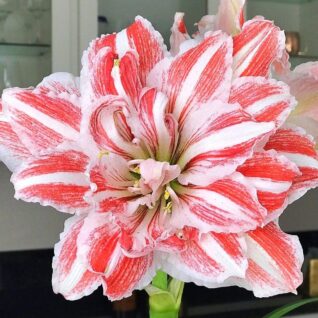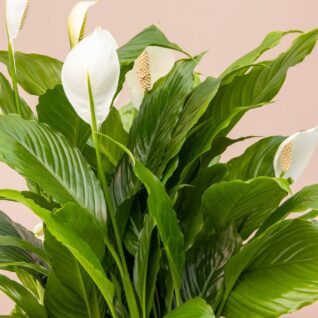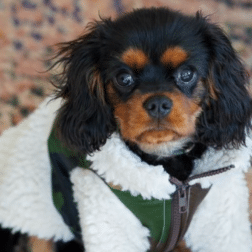We’re all enjoying the fresh air outside and want to take a little of it with us home by bringing indoor plants into our space. It helps rejuvenate, destress us, and recycles the air we breathe. Our plant babies are significant must-have’s, but picking the safe ones for our furry friends is a number one priority. That way, we’re all content, and keep our zen feeling with indoor plants while our pets rest easy too!

@iamtheplantilicious
A list to keep: 5 Dog Friendly Plants and 5 Not So Dog Friendly Plants
@iamtheplantilicious

@livelyroot
Succulents (Echeverias)
Have you tried Echeverias? They are indeed the easiest and most unusual in all their rosette shapes and colors. They are trending from the west to the east coast. And bonus, they’re not high maintenance and fussy. What’s not to love about these? Their leaves are plump with water-holding abilities (which makes them more drought-tolerant), and they love a warm, sunny spot in the landscape or your window sill.
Bromeliad
Everybody wants one after visiting a tropical zone. Bromeliads add color, a tropical vibe and have pups too! Bromeliads flowers show off for months. Once the flower starts to fade, the reproduction sets in, and pups or offsets start to form to continue the hallelujah moment when they flower again. Pet-safe plant!

@livelyroot

@livelyroot
Areca Butterfly Palm (Dypsis lutescens)
Need peace, abundance, and unity? Here is the answer and extra, it’s pet-friendly. The Arecas Butterfly Palm has arching fronds and adds to the positive energy in a room. Feng Shui teaches that you won’t go without, and there will be peace and success within the household. That’s good for pets too! The whole fam can jive together in harmony like ebony and ivory.
Bird’s Nest Fern (Asplenium nidus)
You might be surprised when you see the Bird’s Nest Fern. Its fronds aren’t lacy like some. Instead, they’re undivided and unfurl as they grow in a rosette form suitable for a bird to land and nest in. Its medium-light and low watering needs, and regular humidity make it another fun-to-have plant without the hassle of a diva.

@livelyroot

@livelyroot
Baby Rubber Plant (Peperomia obtusifolia ‘Variegata’)
Get yours now before the rush! The Baby Rubber Plant or Peperomia obtusifolia ‘Variegata’ will be on the red carpet in the category of “Year of the Peperomia” in 2022. Not only will you love the variegated leaves and easy care with low watering requirements, but they play nicely with your fine, furry friends! They lighten a medium-lite space and don’t require extra humidity. Add them to a bedside table to gain the exchange of oxygen for carbon dioxide and breath in fresh air while you and your pooch snooze together.
5 Not So Dog Friendly Indoor Plants

@livelyroot
Ming Aralia (Polyscias fruticosa)
So if your furball doubles as a vacuum cleaner, keep this one on a table out of reach! If you have an Aralia Ming, set it high up where there is no chance of digging or eating the leaves. The cell sap in this plant can cause dermatitis and gastro irritations.
If your plant looks like it has a sudden loss of leaves, watch your pet for signs of redness, itching, blisters, excessive drooling, oral discomfort, and gastrointestinal upset. If so, head to the vet!
Kalanchoe
While your heart may skip a beat with the gorgeous vibrant colors of the Kalanchoe, your little dog’s heart will break. If this plant is eaten, it can cause cardiac symptoms and gastrointestinal irritation. This is an actual ‘heart attack on a plate’ for your furry best friend, so give them treats instead to keep their heart beating strong and lots of kisses coming your way.

@livelyroot

@livelyroot
Amaryllis
There are 600 varieties of Amaryllis in lots of colors and extraordinary blooms that can last weeks in the right environment. But keep them out of reach of your pets because if eaten, they can cause vomiting, depression, diarrhea, abdominal pain, and lots of other symptoms that will be scary.
If your pet is always on a leash, add it to your outdoor plants to enjoy in container plantings. Use them as centerpieces inside but up on a tall table where a dog won’t be able to feast!
Umbrella Plant (Schefflera arboricola)
The shrub-like appearance of Scheffleras vibes well with large indoor spaces except with pets. While it likes to dry out between watering’s, needs average humidity and light, and is considered a low maintenance plant, your pet shouldn’t be around it. If eaten, it can cause oral and gastrointestinal symptoms. The calcium oxalate crystals in the plant are what cause these symptoms if ingested.

@livelyroot

@livelyroot
Peace Lily (Spathiphyllum)
You would think this Peace Lily plant would be easygoing and keep the peace even with your pets, but oh no! It has the same calcium oxalate crystals as the Schefflera. If you must have this one, keep it up on a tall plant stand or in another area of your home where the pet doesn’t enter. Otherwise, it’s known as a top contender on the air-purifying list of who’s who among plants, and their white spathe looks like a white-glove hand wave as they float atop the green, lush foliage.
If you already have some toxic plants in your midst with dogs, keep them huddled and tucked away in a room where pets aren’t allowed. This way, you can still enjoy these plant babies. Or give them to your next-door neighbor and insist on visitation rights!
For those who want to adopt a new pup and want a plant baby too, check out Lively Root. There is a pet-friendly category with lots of great information and recommendations. The Lively Root blog page and YouTube channel are a must to learn about helpful care instructions on various topics about plants. Lively Root believes that each plant and pet deserve a safe environment to cohabitate!




Conversation